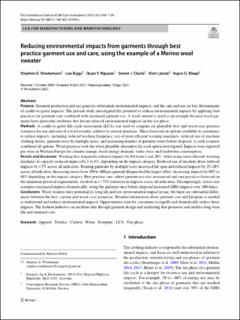| dc.contributor.author | Wiedemann, Stephen G. | |
| dc.contributor.author | Biggs, Leo | |
| dc.contributor.author | Nguyen, Quan V. | |
| dc.contributor.author | Clarke, simon J. | |
| dc.contributor.author | Laitala, Kirsi | |
| dc.contributor.author | Klepp, Ingun Grimstad | |
| dc.coverage.spatial | Australia | en_US |
| dc.date.accessioned | 2022-03-16T14:09:53Z | |
| dc.date.available | 2022-03-16T14:09:53Z | |
| dc.date.created | 2021-04-20T13:15:20Z | |
| dc.date.issued | 2021-04-19 | |
| dc.identifier.citation | The International Journal of Life Cycle Assessment. 2021, . | en_US |
| dc.identifier.issn | 0948-3349 | |
| dc.identifier.issn | 1614-7502 | |
| dc.identifier.uri | https://hdl.handle.net/11250/2985632 | |
| dc.description.abstract | Purpose: Garment production and use generate substantial environmental impacts, and the care and use are key determinants of cradle-to-grave impacts. The present study investigated the potential to reduce environmental impacts by applying best practices for garment care combined with increased garment use. A wool sweater is used as an example because wool garments have particular attributes that favour reduced environmental impacts in the use phase.
Methods: A cradle-to-grave life cycle assessment (LCA) was used to compare six plausible best and worst-case practice scenarios for use and care of a wool sweater, relative to current practices. These focussed on options available to consumers to reduce impacts, including reduced washing frequency, use of more efficient washing machines, reduced use of machine clothing dryers, garment reuse by multiple users, and increasing number of garment wears before disposal. A sixth scenario combined all options. Worst practices took the worst plausible alternative for each option investigated. Impacts were reported per wear in Western Europe for climate change, fossil energy demand, water stress and freshwater consumption.
Results and discussion: Washing less frequently reduced impacts by between 4 and 20%, while using more efficient washing machines at capacity reduced impacts by 1 to 6%, depending on the impact category. Reduced use of machine dryer reduced impacts by < 5% across all indicators. Reusing garments by multiple users increased life span and reduced impacts by 25–28% across all indicators. Increasing wears from 109 to 400 per garment lifespan had the largest effect, decreasing impacts by 60% to 68% depending on the impact category. Best practice care, where garment use was maximised and care practices focussed on the minimum practical requirements, resulted in a ~ 75% reduction in impacts across all indicators. Unsurprisingly, worst-case scenarios increased impacts dramatically: using the garment once before disposal increased GHG impacts over 100 times.
Conclusions: Wool sweaters have potential for long life and low environmental impact in use, but there are substantial differences between the best, current and worst-case scenarios. Detailed information about garment care and lifespans is needed to understand and reduce environmental impacts. Opportunities exist for consumers to rapidly and dramatically reduce these impacts. The fashion industry can facilitate this through garment design and marketing that promotes and enables long wear life and minimal care. | en_US |
| dc.description.sponsorship | This research was funded by Australian Wool Innovation Limited (AWI) with matching research and development funding from the Australian government under project number OF-00490. | en_US |
| dc.language.iso | eng | en_US |
| dc.publisher | Springer | en_US |
| dc.relation.ispartofseries | The International Journal of Life Cycle Assessment;26, pages 1188–1197 (2021) | |
| dc.relation.uri | https://link.springer.com/article/10.1007%2Fs11367-021-01909-x | |
| dc.rights | Navngivelse 4.0 Internasjonal | * |
| dc.rights.uri | http://creativecommons.org/licenses/by/4.0/deed.no | * |
| dc.subject | Apparel | en_US |
| dc.subject | Textiles | en_US |
| dc.subject | Carbon | en_US |
| dc.subject | Water | en_US |
| dc.subject | Footprints | en_US |
| dc.subject | Cradle-to-grave life cycle assessments | en_US |
| dc.title | Reducing environmental impacts from garments through best practice garment use and care, using the example of a Merino wool sweater | en_US |
| dc.type | Peer reviewed | en_US |
| dc.type | Journal article | en_US |
| dc.description.version | publishedVersion | en_US |
| cristin.ispublished | true | |
| cristin.fulltext | original | |
| cristin.qualitycode | 2 | |
| dc.identifier.doi | https://doi.org/10.1007/s11367-021-01909-x | |
| dc.identifier.cristin | 1905321 | |
| dc.source.journal | The International Journal of Life Cycle Assessment | en_US |
| dc.source.volume | 26 | en_US |
| dc.source.issue | 26 | en_US |
| dc.source.pagenumber | 1188–1197 | en_US |
| dc.relation.project | Australian Wool Innovation Limited. Project: OF-00490 | en_US |

